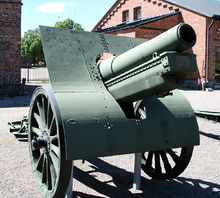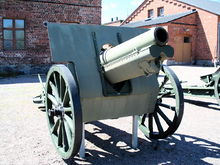|
Armored Train Regiment (Estonia)
The Armored Train Regiment (Estonian: Soomusrongirügement) was an armored regiment of the Estonian Defense Forces from 1934–1940. In 1939, the strength of the regiment was 544 men.[1] The symbol of the regiment was a skull with wings on train wheels, symbolizing how armored trains fought in the Estonian Independence War.[2] History CreationThe Armored Train Regiment was created on November 30, 1934, when the 1st Armored Train Regiment in Tapa was merged with the 2nd Armored Train Regiment into the Armored Train Regiment in Tapa.[2][3] Sports In 1938, the regiment participated in 27 sports competitions, including 16 football matches, of which the regiment won 11. The regiment was also involved in shooting sports.[2][4] 20th AnniversaryOn November 29, 1938, the Armored Train Regiment celebrated the 20th anniversary of the armored trains of Estonia, which date back to 1918 during the Estonian Independence War.[5] Major General Aleksander Pulk, commander of the 1st Division spoke at the regiment's sports field. Around 100 veterans who were personnel of the armored trains during the Independence war attended. A parade was held on the regiment's sports field. Lunch was offered to the veterans after the parade. Colonel Karl Parts, who led and organized armored trains during the Independence War, gave a speech about Rear Admiral Johan Pitka, who is often called "the father of the armored trains".[6] Parts ended his speech by remembering the fallen personnel of the Armored trains in the Independence War and the actions of Captain Anton Irv, who died in 1919. Other military figures, including General Johan Laidoner, Lieutenant general Paul Lill, and Lieutenant general Nikolai Reek sent telegrams. The celebration continued until the next day on November 30, 1938.[2] Disbandment of the regimentIn June 1940, the Soviet Union invaded and annexed Lithuania, Latvia, and Estonia. The Estonian army was formed into the 22nd Rifle Corps and the 22nd Territorial Rifle Corps of the Red Army.[7] The regiment was dissolved and it's artillery cannons were transferred to Russia.[2] During the June Deportation, the regiment's commander from 1936 to 1940, Voldemar Karl Koch (later Koht), was arrested and deported to Siberia in June 1941. Koch was executed in Norilsk in September 1942.[8][9] The regiment's commander from 1940 to 1941, Erich Johann Friedrich Toffer, was arrested and deported by the NKVD. Toffer died later in 1945.[3] Organisation The regiment was located in Tapa, and it consisted of two divisions, each with their own machine gun and infantry companies:[1][2] First DivisionThe First Division consisted of 2 armored trains, a machine gun company, and infantry company.[3] Armored TrainsThe armored train(s) of the First Division was Broad-gauge armored train "Kapten Irv" (nr. 1) and Broad-gauge armored train nr. 2. Second DivisionThe Second Division consisted of 1 armored train, a machine gun company, a heavy long-range artillery company, and infantry company. The Chief of Staff of the Second Division was the former commander Voldemar Karl Koht from 1940 to the occupation of Estonia during the Second World War.[2] Heavy Long Range BatteryThe Heavy Long-Range Battery (Estonian: Raskekauglaskepatarei) was a long-range artillery unit, which included three artillery wagons. The cannons came from former naval artillery pieces.[10] These artillery wagons were used for long range bombardment and could fire two times as farther than the cannons of the artillery wagons.[3] Armored TrainsThe armored train(s) of the Second Division were Broad-gauge armored train nr. 3. EquipmentIn 1940, the regiment had 16 Maxim M1910 heavy machine guns.[1] Cannons and ArtilleryIn the late 1930s, the Armored Train Regiment had a total of 16 artillery wagons, 8 light, 4 mixed, 4 heavy artillery.:[1] The regiment also had 3 naval artillery pieces[10]      
Armored trains There were 3 armored trains in the regiment:[1]
Notes
References
External links |
||||||||||||||||||||||||||||||||||||||||||||||||||||||||||||||||||||||||||||||||||||||||||||||||||||||||||||
